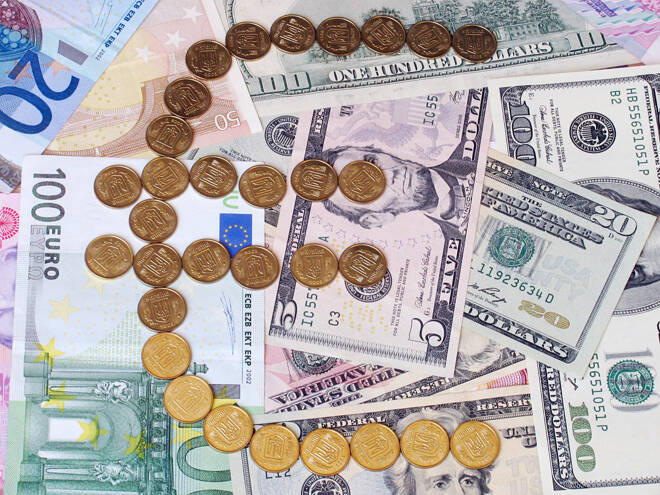Advertisement
Advertisement
An Economic Data Deluge from the Eurozone Weighs on the EUR
By:
A data deluge from the Eurozone led the EUR back to sub-$1.21 levels before finding support. GDP numbers from Germany were aligned with the recent downward revision to growth forecasts.
It’s been a particularly busy day on the Eurozone economic calendar. Following a relatively busy Asian economic calendar, the French, German, and the Eurozone economies were in focus.
From France, consumer spending, inflation, and 1st quarter GDP figures were in focus.
German and Eurozone GDP numbers for the 1st quarter also drew attention alongside prelim Eurozone inflation figures for April.
French Data
In March, consumer spending fell by 1.1% reversing a 0.3% rise from February. Economists had forecast a 0.4% rise.
According to Insee.Fr,
- A marked fall in manufactured goods purchases (-3.7%) stemming from the reintroduction of lockdown measures weighed.
- By contrast, spending on energy rose by 1.3%, with food consumption up 0.8%. Spending on both had fallen in the month prior.
Inflationary pressures picked up in April, according to prelim figures. The annual rate of inflation accelerated from 1.1% to 1.3%.
According to Insee.Fr,
- An acceleration in prices for services and for energy delivered inflationary pressures.
- Prices for services increased by 1.3%, year-on-year, after a 1.1% rise in March.
- Energy prices jumped by 8.8% compared with April 2020. In March, prices had increased by 4.7%.
- Consumer prices rose by 0.2% in the month, following a 0.6% increase in March.
While consumption figures disappointed at the end of the 1st quarter, GDP numbers came in ahead of forecasts.
The French economy expanded by 0.4% in the 1st quarter, coming in ahead of a forecasted 0.1% growth. In the 4th quarter, the economy had contracted by 1.4%.
According to Insee.Fr,
- Final internal demand (excl. inventory changes) made a positive contribution (+0.9 points after -3.0 points in Q4).
- Gross fixed capital formation intensified its dynamic (+2.2% after +1.3%), with households’ consumption expenditure up marginally (+0.3% after a strong slide of -5.7% in Q4).
- Exports declined 1.5% compared with a 0.1% fall in imports, making a negative contribution (-0.4 points).
German Economy
In the 1st quarter, the German economy contracted by 1.7%, which was worse than a forecasted 1.5% contraction. The German economy had expanded by a modest 0.3% in the 4th quarter.
Year-on-year, the economy contracted by 3.3% in the 1st quarter. The economy had contracted by 2.7% in the final quarter of last year. Economists had forecast a contraction of 3.6%.
According to Destatis,
- Household consumption weighed, while exports supported the economy.
- When compared with the 4th quarter of 2019, the quarter before the coronavirus began, GDP was 4.9% lower in Q1 of 2021.
The Eurozone
For the Eurozone, inflationary pressures continued to pick up, with the annual rate of inflation accelerating from 1.3% to 1.6% in April.
According to Eurostat,
- Energy is expected to have the highest annual rate in April (10.3%, compared with 4.3% in March), followed by services (0.9% compared with 1.3% in March).
- Food, alcohol, & tobacco prices are expected to rise 0.7% (+1.1% in March) and non-energy industrial goods up by 0.5% (+0.3% in March).
- Month-on-month, consumer prices rose by 0.6%, according to prelim figures. In March, consumer prices had risen by 0.9%.
In the 1st quarter, the Eurozone economy contracted by 0.6%, quarter-on-quarter, and by 1.8% compared with Q1 2020.
Economists had forecast a quarterly contraction of 0.8% and a year-on-year contraction of 2.0%.
In the 4th quarter, the economy had contracted by 0.7% quarter-on-quarter and by 4.9% year-on-year.
According to Eurostat,
- Amongst the member states, Portugal (-3.3%) recorded the largest quarter-quarter contraction, followed by Latvia (-2.6%), and Germany (-1.7%).
- Lithuania (+1.8%) recorded the largest increase.
- Year-on-year, growth rates were negative for all countries except for France (+1.5%) and Lithuania (+1.0%).
While the Eurozone economy contracted once more in the 1st quarter, the unemployment rate eased from 8.2% to 8.1%.
Market Impact
Ahead of today’s data, the EUR had struck an early pre-stat and current day high $1.21267 before hitting reverse.
Through the release of today’s stats, the EUR fell to a current day low $1.20944, with economic indicators favoring the Dollar.
At the time of writing, the EUR was down by 0.22% to $1.20952.
Next Up
Personal spending and inflation figures from the U.S are amongst key stats. Chicago PMI and finalized consumer sentiment numbers for April are also due out late in the European session.
About the Author
Bob Masonauthor
With over 28 years of experience in the financial industry, Bob has worked with various global rating agencies and multinational banks. Currently he is covering currencies, commodities, alternative asset classes and global equities, focusing mostly on European and Asian markets.
Advertisement
